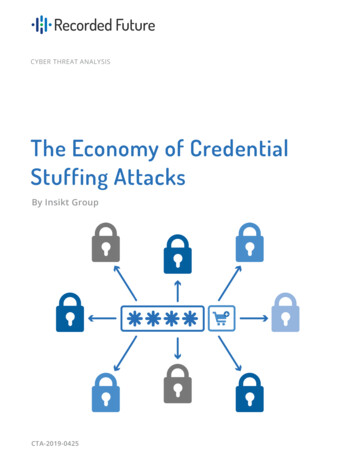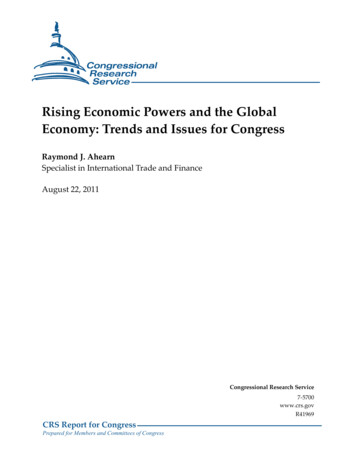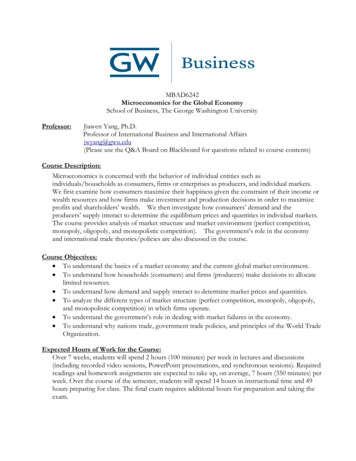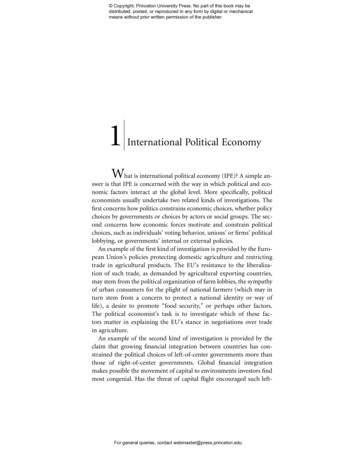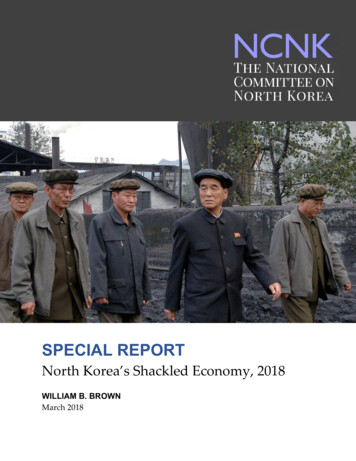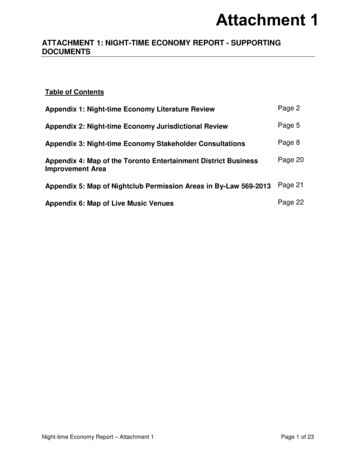
Transcription
Attachment 1ATTACHMENT 1: NIGHT-TIME ECONOMY REPORT - SUPPORTINGDOCUMENTSTable of ContentsAppendix 1: Night-time Economy Literature ReviewPage 2Appendix 2: Night-time Economy Jurisdictional ReviewPage 5Appendix 3: Night-time Economy Stakeholder ConsultationsPage 8Appendix 4: Map of the Toronto Entertainment District BusinessImprovement AreaPage 20Appendix 5: Map of Nightclub Permission Areas in By-Law 569-2013Page 21Appendix 6: Map of Live Music VenuesPage 22Night-time Economy Report – Attachment 1Page 1 of 23
APPENDIX 1: NIGHT-TIME ECONOMY LITERATURE REVIEWThe topic of the night-time economy is one of scholarly interest since the mid-1990s totoday (Bianchini, 1995) (Wolifson & Drozdzewski, 2017). The academic articlesreviewed mostly focused on night-time economy examples from Europe such asNorthern England, Scotland, Germany, The Netherlands, Denmark, France and Italy.The United States was also a popular region for case studies of cities such as LosAngeles, Philadelphia, Baltimore, Cincinnati and New York. As well, there were articlesabout nightlife in Turkey, Mexico, Argentina and Singapore.Academic research on the night-time economy tended to fall into at least one of thefollowing four categories: Urban regeneration through the night-time economy (Hollands & Chatterton, 2003),Live music venues at night and the music industry more generally (Brown, O'Connor,& Cohen, 2000),Nightlife by-laws and safety (Roberts & Turner, 2004) (Rowe & Bavinton, 2011) (vanLiempt & van Aalst, 2012), andAddressing nightlife barriers such as socio-economic status, age, gender, sexualorientation or religious beliefs (Valentine & Holloway, 2010) (Warren & Evitt, 2010)(Hae, 2011).The major findings from the literature review are that the night-time economy is not newand not unique to Toronto. As well, the presence of the night-time economy in cities isnot visible during the day, and not widely recognized as a valued contributor to theeconomy.Through academic publications there is evidence that cities around the world haveleveraged the night-time economy as a post-industrial regeneration strategy since the1980s, and have explored the concept of the 24 hour economy since the 1990s (Heath,1997). The night-time economy is present in many advanced capital economies,particularly those in dense urban areas with empty manufacturing plants or abandonedindustrial waterfronts, and where the service sector has become a strong contributor ofeconomic growth. Night-time businesses are a type of agglomeration activity and areusually clustered in particular areas of the city such as entertainment districts, corridors,streets, or blocks (Campo & Ryan, 2008) (Marquardt & Henning, 2012). However, nighttime businesses are hard to see during the day because spaces are shuttered duringdaytime hours, or are being used during the day for other purposes. Relatively fewpeople in the daytime economy know about night-time scenes in their city. As a result,the night-time economy is an often overlooked topic of official economic developmentstrategies, local cultural development efforts and cultural policy studies. It is also aperipheral topic within academic research on the music industry, which had mostlyfocused on music publishing and has only recently started to study live music (Cloonan,2011).The academic research also points to the following potential benefits of creating a nighttime strategy:Night-time Economy Report – Attachment 1Page 2 of 23
Night-time is a New Way of Addressing Creative City Development - There is anintegral relationship between the culture sector and the night-time economy becauseof the high degree of consumption activities that take place at night, and the numberof creative workers that work at night. Investment in Night-time Can Create a Stronger 24H Economy - A night-timeeconomy strategy can be a mechanism for boosting local brands, diversity, anddistinctive regional tastes both in terms of cultural services and local consumerproducts such as craft beer. It is an Opportunity to Develop a More Seamless Transition Between Daytime andNight-time through "Cross-Over" Activities - Daytime and night-time "cross-overs"are happening both through activities such as museum nights or early theatre showson weeknights, and in venues that during the day are gyms, temporary event spacesor meeting rooms, and at night are live music venues, restaurants or nightclubs. A Plan for Night-time Can Actually Increase Safety - By creating a strategy aroundthe night-time economy, the city will become safer through proactive strategies forreducing crime and residential disturbances, and attracting a broad section of peopleinto the city at night. Attention to Night-time can Foster a Better Understanding of Daytime EconomyTrends - The circulation of cultural products and experiences at night throughcreative industries such as fashion, art and music, and driven by a social life throughclubs, galleries, music venues and fashion shows, can stimulate the economyoverall (Currid, 2007).Night-time Economy Report – Attachment 1Page 3 of 23
Works CitedBianchini, F. (1995). Night Cultures, Night Economies. Planning Practice & Research,10(2), 121-126.Brown, A., O'Connor, J., & Cohen, S. (2000). Local music policies within a global musicindustry: cultural quarters in Manchester and Sheffield. Geoforum, 31(4), 437451.Campo, D., & Ryan, B. (2008). The Entertainment Zone: Unplanned Nightlife and theRevitalization of the American Downtown. Journal of Urban Design, 13(3), 291315.Cloonan, M. (2011). Researching live music: some thoughts on policy implications.International Journal of Cultural Policy, 14(4), 405-420.Currid, E. (2007). The Warhol Economy: How Fashion, Art and Music Drive New YorkCity. New York City: Princeton University Press.Hae, L. (2011). Dilemmas of the Nightlife Fix: Post-industrialisation and theGentrification of Nightlife in New York City. Urban Studies, 48(16), 3449-3465.Heath, T. (1997). The twenty‐four hour city concept—A review of initiatives in Britishcities. Journal of Urban Design , 2(2), 193-204.Hollands, R., & Chatterton, P. (2003). Producing nightlife in the new urbanentertainment economy: corporatization, branding and market segmentation.International Journal of Urban and Regional Research, 27, 361–385.Marquardt, N., & Henning, F. (2012). Spillover of the private city: BIDs as a pivot ofsocial control in downtown Los Angeles. European Urban and Regional Studies,19(2), 153-166.Ontario Ministry of Tourism, C. a. (2015). Tourism Statistics. Toronto CensusMetropolitan Area. Ontario, Canada.Roberts, M., & Turner, C. (2004). Conflicts of Liveability in the 24-hour City: Learningfrom 48 Hours in the Life of London's Soho. Journal of Urban Design, 10(2), 171193.Rowe, D., & Bavinton, N. (2011). Tender for the night: After-dark cultural complexities inthe night-time economy. Continuum, 25(6), 811-825.Toronto, C. o. (2017, February 27). Toronto at a Glance. Retrieved from City of a-research-maps/toronto-at-a-glance/Toronto, C. o. (2017, August). Toronto Music Directory, Economic Development andCulture. Music Venues. City Planning.Toronto, C. o. (2018, Februrary 28). Business Licence Look-up. Retrieved from City ofToronto: to, C. o. (2018). TOcore Planning Toronto's Downtown, City Planning. RetrievedMarch 1, 2018, from ing-torontosdowntown/tocore-overview/Tourism, C. o. (2017, February 27). Tourism. Retrieved from City of dustry-sector-support/tourism/Valentine, G., & Holloway, S. (2010). Contemporary cultures of abstinence and thenighttime economy: Muslim attitudes towards alcohol and the implications forsocial cohesion. Environment and Planning, 42, 8-22.van Liempt, I., & van Aalst, I. (2012). Urban Surveillance and the Struggle between Safeand Exciting Nightlife Districts. Surveillance and Society , 9(3), 280-292.Night-time Economy Report – Attachment 1Page 4 of 23
Warren, A., & Evitt, R. (2010). Indigenous Hip-hop: overcoming marginality,encountering constraints. Australian Geographer, 41(1), 141-158.Wolifson, P., & Drozdzewski, D. (2017). Co-opting the Night: The Entrepreneurial Shiftand Economic Imperative in NTE Planning. Urban Policy and Research, 35(4),486 - 504.Night-time Economy Report – Attachment 1Page 5 of 23
APPENDIX 2: NIGHT-TIME ECONOMY JURISDICTIONAL REVIEWThe jurisdictional review confirmed that in the past decade cities around the world havebegun to approach time of day as the new competitive edge for urban development. Aspart of the jurisdictional review, Amsterdam's original Night Mayor, Mirik Milan, said bytelephone, "Planning the city for night-time is not different than planning the city fordaytime - it's just never been done before".From the creation of new nightlife management programs, to the development of masterplans, cities are starting to approach night with the same level of attention andawareness that they invest in the day. The jurisdictional review accessed informationfrom local government websites, reports, and direct communication through email andtelephone with relevant experts in Amsterdam, London (UK), Montreal, New York City,Paris, Seattle and Sydney. Through the Responsible Hospitality Institute (RHI) EDCDivision also contacted staff at the City of Calgary and the City of Edmonton, who havepreviously worked with RHI on downtown nightlife management strategies.There is no single model for night-time economy management in cities - it can beindustry led, municipally led, or some combination of both. Most cities with a successfulnightlife have at least one of the following: an identified city lead (can be internal orexternal), staff in a local government film, music, media and entertainment office thatcan work with other city divisions, a mechanism to coordinate nightlife industry andstakeholder input on an ongoing basis, and a nightlife action plan or master plan.Amsterdam and London - Identified City Leads for the Night (Internal or External)The most widely recognized city in the world to advance nightlife leadership isAmsterdam. In 2002, faced with the obstruction of nightlife in Amsterdam, localpoliticians developed the idea of establishing a Night Mayor office for the city. The NightMayor office is a local independent not-for-profit organization that is funded by themunicipal government, nightlife industry businesses, and earned revenue through selfproduced events. While there is a daily working relationship with city hall, and a closepromotional relationship between the elected Mayor and Amsterdam's "Night Mayor",structurally the Night Mayor office operates at arm's length to the local government.Mirik Milan, the original Night Mayor of Amsterdam, was first elected in 2012 and reelected in 2014. Shamiro van der Geld was elected as Night Mayor of Amsterdam inFebruary 2018 for a three year term. The Night Mayor is selected by a jury of fivemembers with five votes, online voters that combined have one vote, and the generalpublic that combined have one vote. Anyone can nominate themselves for the election.The purpose of the Night Mayor is to be a 'rebel' in a suit and work across stakeholdersto introduce new programs that enhance the cultural value of nightlife. For example, lastyear the Night Mayor office piloted a program to offer ten 24 hour licences to venueslocated outside the downtown core in Amsterdam. Successful venues needed to showcuration of music programming and added community cultural benefits such as: offeringco-working spaces, gyms, galleries and daycare spaces during the day. The next roundof issuing ten 24 hour licences will focus on small to mid-sized venues that programNight-time Economy Report – Attachment 1Page 6 of 23
local start-up bands to support the city's future cultural production, and foster a sociallyand ethnically inclusive nightlife.London has followed Amsterdam's lead and in 2016 created a Night Czar position thatis appointed by the city's Mayor. The Night Czar was originally intended as a part-timeposition, however it has since become a full-time position. London's Night Czar is saidto be one of the highest public profile positions of the city government, second only tothe Mayor. As the Night Czar is so closely connected to the city's Mayor, the Night Czaris prone to political attacks and critiques from the media or the general public. The NightCzar position handles day-to-day issues, music and nightlife promotion, and issupported through a unit within the bureaucracy that focuses on nightlife managementand music development. In addition to the Night Czar, the Mayor of London introduced24 hour licences in London, 24 hour subway service on Friday and Saturday nights(called the Night Tube), and established a Night-time Commission with representativesfrom a broad group of nightlife stakeholders to address longer-term policy developmentfor the night-time economy. As more and more people, particularly in the lowereconomic strata, are working at night, developing the night-time economy has a socialjustice element to it. In 2017, the Mayor of London released the planning documentcalled From Good Night to Great Night: A Vision for London as a 24 Hour City. One ofthe principles of the Mayor's vision for nightlife is to take account of "future global anddomestic trends in leisure, migration, technology, employment and economics".Berlin and Paris - Ongoing Coordination of Nightlife Industry and StakeholdersIn addition to elected representatives (either through industry/audience/public electionsor through politically elected appointments), the European model is also founded on theinitiative of nightlife industry coordination. For example, Berlin's Clubcommission is anassociation of nightclubs, party and cultural event organizers promoting t
Night-time businesses are a type of agglomeration activity and are usually clustered in particular areas of the city such as entertainment districts, corridors, streets, or blocks (Campo & Ryan, 2008) (Marquardt & Henning, 2012). However, night-time businesses are hard to see during the day because spaces are shuttered during daytime hours, or are being used during the day for other purposes .
